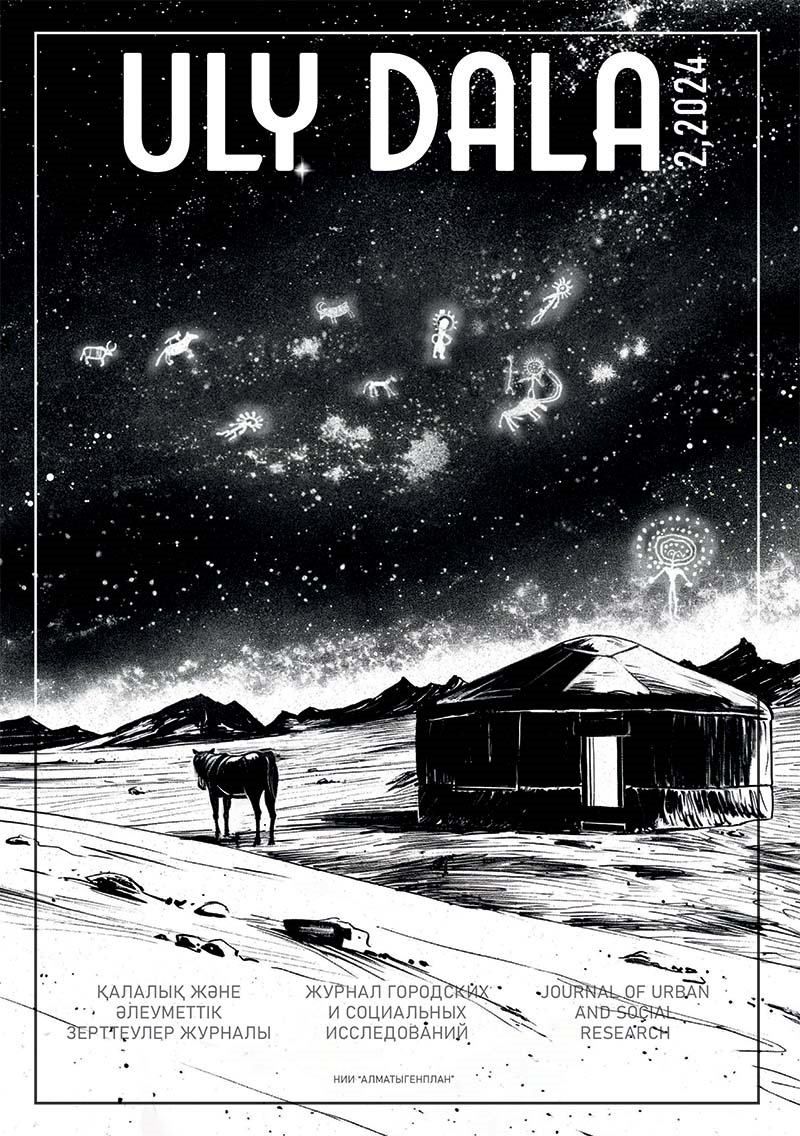The symbolism of sun and horse imagery: from ancient Tamgaly petroglyphs to modern national discourse
Keywords:
rock art, Bronze Age, early Iron Age, shamanism, sun and horse imagery, Tamgaly petroglyphsAbstract
This article examines the Bronze Age context of the Tamgaly Valley petroglpyphs and the modern context of sun and horse imagery. In my article, I try to answer the question what the sun and horse imagery symbolized in the context of the Bronze Age — early Iron Age period, and what it symbolizes today in the national political imagery of Kazakhstan. The research uses the concepts of agency and doxa, as well as contextual and symbolic approaches, as theoretical frameworks. The methodology is the visual analysis of scanned images taken from Rozwadowski (2001), Hermann (2011), UNESCO photographs and Tanbaly Museum photographs. The article suggests that the sun and horse imagery at Tamgaly Valley portrayed the ancient spiritual symbolism, in which horned horses and ‘so-lar-headed’ figures had sacred meanings. Furthermore, I add the ritualistic perspective to the horse domestication debate — perhaps, the shamans who held specific knowledge and experience also knew how to tame and control the horse, and used their knowledge and status for ritual purposes.
References
Akorda.kz. (n.d.). [Photograph]. Retrieved March 14, 2024, from
bahB8QQMygDegQIARBX..i&imgrefurl=https%3A%2F%2Fwww.akorda.
kz%2Fen%2Fstate_symbols%2Fkazakhstan_flag&docid=ebpXxoELCwCldM&w=750&h=357&q=national%20flag&ved=2ahUKEwiw0b6gtvuEAxVMMRAIHbahB8QQMygDegQIARBX
Akorda.kz. (n.d.). [Photograph]. Retrieved March 14, 2024, from
kz%2Fen%2Fstate_symbols%2Fkazakhstan_emblem&docid=DCYE0ndiqm
LU9M&w=3600&h=3734&q=national%20emblem%20of%20kazakhstan&ved=2ahUKEwiZ8fantvuEAxW2GhAIHcZ4ALMQMygAegQIARBN
Arsenault, Daniel & Zawadzka, Dagmara. (2014). Spiritual Places: Canadian Shield Rock Art within its Sacred Landscape. Rock Art and Sacred Landscapes, 117–137.
Bourdieu, Pierre. (1977). Outline of a Theory of Practice (R. Nice, Trans.).
Cambridge: Cambridge University Press.
Britannica. (2024). Shamanism. https://www.britannica.com/topic/shamanism
Devlet, Ekaterina. (2001). Rock art and the material culture of Siberian and
Central Asian shamanism. In N. Price (Ed.), The Archaeology of Shamanism
(pp. 43-55). Routledge.
Dosmurzinov, Rustem. (2023). Pre-islamic World Views of the Kazkah People: from the End of the 19th to the Beginning of the 21st Century. Trames,
27(77/72), 415–438.
Eliade, Mircea. (1992). Shamanism: Archaic Techniques of Ecstasy. Princeton
University Press.
Freepik. (n.d.). [Photograph]. Retrieved November 19, 2023, from https://
ru.freepik.com/premium-photo/shanyrak-bottom-view-from-kazakh-yurtsymbol-of-kazakhstan_40072983.htm
Hermann, Luc. (2011). Rock Art of Tamgaly, Kazakhstan. Adoranten, 26–40.
Jacobson-Tepfer, Esther. (2012). The Image of The Wheeled Vehicle In The
Mongolian Altai: Instability And Ambiguity. The Silk Rouad, 10, 1–28.
Kaul, Flemming. (2018). The Chariot of the Sun and other sun horses of the
Nordic Bronze Age — including some interesting anatomical details. In
J. Dodd, & E. Meijer (Eds.), Giving the Past a Future: Essays in Archaeology
and Rock Art Studies in Honour of Dr. Phil h.c. Gerhard Milstreu, 58–69. Archaeopress.
Kemelbekova, E., & Bukharova, G. (2002). Semantics of Geometric Forms in
Nomadic Culture. 152–155.
Oers, Ron Van. (2009). Petroglyphs of the Archaeological Landscape of Tanbaly [Photograph]. UNESCO. whc.unesco.org/en/documents/115298
Outram, Alan K., Natalie A. Stear, Robin Bendrey, Sandra Olsen, Alexei
Kasparov, Victor Zaibert, Nick Thorpe, Richard P. Evershed. (2009). The Earliest Horse Harnessing and Milking. Science, 323, 1332—1335.
Price, Neil. (2011). Shamanism. In T. Insoll (Ed.), The Oxford Handbook of
the Archaeology of Ritual & Religion (pp. 983-1003). Oxford University Press.
Rogozhinsky, Alexey. (2011). Petroglyphs within the Archaeological Landscape of Tamgaly. Almaty.
Rozwadowski, Andrzej. (2014). Rock Art and Shamanism: Phenomenology,
Context and Ethics. Theory and Practice of Archaeological Research, 2(10),
57–72.
Rozwadowski, Andrzej. (2001). Sun Gods or Shamans? Interpreting the ‘Solar-Headed’ Petroglyphs of Central Asia. In: N. Price (Ed.), 2001, Archaeology
of Shamanism, 65-86, London, New York: Routledge.
Sarbassova, Guldana. (2015). Language and Identity in Kazakh Horse Culture. Bilig, 75, 227–248.
Silliman, Stephen. (2001). Agency, practical politics and the archaeology of
culture contact. Journal of Social Archaeology, 1(2), 190–209.
Taylor, William, & Barron-Ortiz, Christina. (2021). Rethinking the evidence
for early horse domestication at Botai. Sci Rep 11(7440), 1–11.
Vincent, Ko Hon Chiu. (2008). Petroglyphs of the Archaeological Landscape
of Tanbaly [Photograph]. UNESCO. whc.unesco.org/en/documents/147315
Заповедник музей “Таңбалы”. Могильники. https://tanbaly.kz/burialgrounds
— Zapovednik muzey “Taňbaly”. (n.d.). Mogylʹnyky. https://tanbaly.kz/burialgrounds
Заповедник музей “Таңбалы”. Петроглифы. https://tanbaly.kz/petroglyphs
— Zapovednik muzey “Taňbaly”. (n.d.). Petroglify. https://tanbaly.kz/petroglyphs
Рогожинский, Алексей. (2004). Памятники наскального искусства Центральной Азии: Общественное участие, менеджмент, консервация, документация. Алматы.
— Rogozhinsky, Aleksey. (2004). Pamyatniki naskal’nogo iskusstva Tsentral’noy
Azii: Obshchestvennoye uchastiye, menedzhment, konservatsiya, dokumentatsiya.
Almaty.
Рогожинский, Алексей. (2009). Наскальные изображения “солнцеголовых” из Тамгалы в контексте изобразительных традиций бронзового
века Казахстана и Средней Азии. В К. Табалдиев, Е. Смагулов & П. Петров (ред.), Материалы и исследования по археологии Кыргызстана, 4
(53–65). Бишкек: Илим.
— Rogozhinsky, Alexey. (2009). Naskal’nyye Izobrazheniya “Solntsegolovykh” Iz
Tamgaly v Kontekste Izobrazitel’nykh Traditsiy Bronzovogo Verka Kazakhstana
I Sredney Azii. In K. Tabaldiyev, Y. Smagulov & P. Petrov (Eds.), Materialy i
issledovaniya po arkheologii Kyrgyzstana, 4 (53–65). Bishkek: Ilim.
Самашев, Зайнолла. (2011). Берел. Алматы: “Таймас” Баспа үйі.
— Samaşev, Zaynolla. (2011). Berel. Almatı: “Taymas” Baspa üyi.
Самашев, Зайнолла, Базарбаева Галия, Джумабекова Гульнара, & Сагынтай Сунгатай. (2000). Berel-Берел. Альбом. Алматы.
— Samashev, Zaynolla, Bazarbayeva Galiya, Dzhumabekova Gulnara, & Sagyntai
Sungatai. (2000). Berel-Berel. Al’bom. Almaty.
5th World Nomad Games Astana 2024. (n.d.). https://worldnomadgames.kz/
en/news/ob-igrah
Downloads
Published online
Issue
Section
License

This work is licensed under a Creative Commons Attribution-NonCommercial 4.0 International License.

